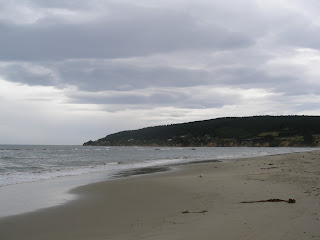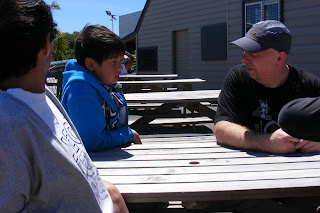Otaga University is just a stone’s throw from Dunedin Octagon City Centre, about a 5 minute drive from my motel. I had arranged to meet Dr. Mark Lokman, a senior lecturer and researcher at the Department of Zoology. Mark is a specialist in Endocrinology, particularly the mechanisms for fish reproduction and particularly eels. Mark studied eel breeding with the Japanese and is actually married to a Japanese lady, although he tells me that he met her in a Sushi restaurant in Dunedin.
The Zoology main building is an old redbrick structure but has been expanded hugely with some very modern offices, labs and lecture rooms. Bang on 9.30 I turned up to Marks office and we had a coffee and discussion regarding my visit and the work I am involved in back home.
Zooology building
After this Mark gave me a short tour of the lab and breeding facilities and introduced me to his students. The two chaps working on Eels were Sean and Matt. After this initial visit it was a nice long chat in the coffee room with Sean and Matt about Eels and fisheries in general.
The main aquatic wet lab
The Mark had arranged something really special for me, we were going to examine a mature female New Zealand Short Fin eel and take a biopsy of her eggs to check the stage of development. So Matt took out this large “fat female” who was surprisingly docile even without anaesthetic. She was carefully placed on a damp towel and her eyes covered to keep her calm. It always amazes me how covering the eyes seems to calm down all animals!!!!!! I think we should try this with troublesome members of society…….oh wait we have it already, it’s called pepper spray.
Matt then inserted a catheter attached to a small syringe into the reproductive vent and proceeded to extract a few eggs which we placed under the low power microscope for inspection.
sampling eggs from ripe female
This was really cool and apparently critical to the final maturation injection. There is something like 10 egg development stages identified for eel eggs and if you don’t get the right stage then the final maturation injection will not work and the eggs will be non-viable. Fortunately for us the eggs were at about stage 5-6 (as determined by the number of oil droplets in the egg) and so she was ready for the final injection later that night.
After a late lunch and further discussion it was time to leave the guys to it and I was invited to return the following day when the eggs would be ready for “stripping” precisely 10 hours after the final injection (nature is a marvellous thing).
Mark had said the Dunedin Museum was worth a look and also that I should check out the worlds steepest street a few blocks away. The museum was indeed very good, a mixture of natural and cultural history with some really modern displays.
Excellent Dunedin museum
The world’s steepest street, Baldwin Street was amazing, it made you feel dizzy just looking to the top, it was scary, I certainly wouldn’t have taken the hire car up there. Just then someone took a big four wheel drive thing up the hill, it was like one of those cars from the film “Mad Max” it struggled, engine racing, to a stop about 20 yards from the top. Then the engine started and roared and the car crept over the top in a huge cloud of black smoke…..awesome.
Baldwin Street
Went home via Countdown, the big supermarket chain, and got some nice bread and garlic sausage for tea. The internet was really good in my room so I was able to do a lot of work and admin stuff without interruption.
The last hour of the evening I like to stroll downtown with my book by Michael Brown (the life of an eel fisherman) and read a few pages whilst sipping a cold beer.
A really good day, roll on tomorrow.
Thursday 2nd February
Had to be at the University for 8.30am so we could check the male fish for ripeness and strip and store the sperm ready for the fertilisation around mid-day some time.
Matt and Mark got straight into it, lifting all the males (easy to tell as they are usually a good 5th or quarter of the size of the females) out of the tank and into a salt water solution in a bucket with a little bit of clove oil for anaesthetic. The anaesthetised eels were all laid out together on a damp towel and just left there while the process began. This was amusing to me as if you had done this with salmon the second fish to be processed would likely not have recovered and certainly the third fourth and 5th etc. would have perished. I knew, like most people that eels can move overland but mark said that they can stay out of water for hours as long as they are moist 9they can absorb oxygen through the skin).
Each male was gently squeezed along the abdomen and a clean pipette was used to collect the neat sperm which was store in a small plastic tube with a lid called an eppendorf tube.
When all the males were done (about 20 !!!) we took the tubes, stored on iced, up to tone of the labs to check for motility. This was basically the same as we do with our salmon. A small amount of sperm is added to a clean slide and then to activate the sperm, salt water was added. The slide was then quickly focussed under the X 10 lens on a high power microscope and an estimate made of the % of motile sperm (i.e. those actively swimming around trying to find and egg). It was surprisingly low on average, around 10%.
Mark checking sperm motility
With the sperm samples ready we prepared to strip the female at 12.00 mid-day. The signs were good, she was enlarged and some eggs were dripping from her. Matt and Sean dried her off and each held and “end” whilst they lifted her up so that the vent was directly over the stripping bowl. The crude process of manual stripping involves gently squeezing the abdomen until the eggs physically run out of the vent, too soft and they won’t move, too hard and you can damage organs.
Matt and Sean stripping eggs from the female
Fortunately the eggs seemed to come out pretty easily, a sort of opaque gelatinous goo with the eggs just visible at about just over 1mm in diameter. As with salmon eggs the sperm vials were added and mixed in before the sperm were activated with water and started swimming for the micropyle (hole in the egg).
This was really neat and something I had not seen before and what I was here to learn about. You can read as many papers and text books as you like but until you see the actual process for yourself you don’t really become proficient. Sean was not too impressed with the way these eggs were developing, he reckoned they were a bit early. You can tell by the rate of water absorption and the time of the first few cell divisions (looking under low power) as too whether the eggs will survive or not.
So after lunch we decided to have one more go and this time I got to help strip the female which was good experience for me. Sea was too confident about the quality of the eggs though. The eggs were put into a basic aerated incubator (the good ones float and the bad ones sink)and left overnight.
Matt and I stripping the remaining eggs
Sean told me that the eggs would be shipped up North to Nelson so that they could have a go at rearing them through to larvae. Ironically it was the same shellfish hatchery that I had visited 10 years ago on holiday.
fertilised eggs in incubator
So that was it for me, after much hand shaking and many a heartfelt thank you it was time to move on. Not for the first time on this trip I went away marvelling at the kindness of total strangers and how they give up their time to help you.
Well, I knew it was going to be a long drive up to Christchurch (about 4 hrs. without a stop) so I hit the road pretty much straight away.
It was a cracking drive again but this time I was more focussed on reaching my motel before it got dark and before the kids went to bed back home, this is always important to me and rounds the day off nicely. I never feel that good if a day goes by without speaking to home.
The journey was very smooth and I got to really like the New Zealand talk radio….. I think the whole four hours of the show was taken up by people phoning in competing for the best “drop you kids off at school a day early (before term time)…story”. Got to my Motel on the edge of the Central Business District without error by following my hand scribbled notes and a rather vague tourist map, who needs Sat Nav.
Just time to chuck my stuff in the room and skype home. The Motel manager was careful to explain about the wireless internet and that the signal was not too good and prone to drop out which actually turned out to mean that it didn’t work!!!! This was the most annoying thing about my trip, I had carefully chosen my hotel destinations so that they had good and preferably free internet access. This was so important for communicating with the next port of call, keeping up with finances and bookings and also keeping in touch with home. I would say that 50% of establishments either had “broken” servers or misled you with their claims of “free Wi Fi” – i.e. it’s free for the first 20 mins or 5mb, whichever comes first. This really bugged me as it was one of the most important criteria for me. I wonder how people used to carry out long term travel before the internet and mobile phones, at the very least I could text.
Evidence of the earthquake in February was all around, in fact the old Church across the street from the motel was ¾’s demolished. Walking around you could see strange empty lots where the grass had grown over and it look like a new building plot, obviously where a house had been pulled down some months earlier. It was strange how some properties were clearly showing the worse for wear, with great cracks and then heaps of scaffolding and huge supports all over, whilst next door was fine!! You couldn’t help feeling sorry for the poor folk who’d lost everything and the fact that re-building was taking so long, the whole of the central business district was still fenced off to pedestrians and weekly aftershocks were still happening. Still everybody seemed used to it somehow, I guess they had no choice but to carry on with their daily lives.
Well, it had been a good spell in New Zealand and I must admit to being a little sad, tomorrow it was off to the USA and the last phase of my journey.



















































